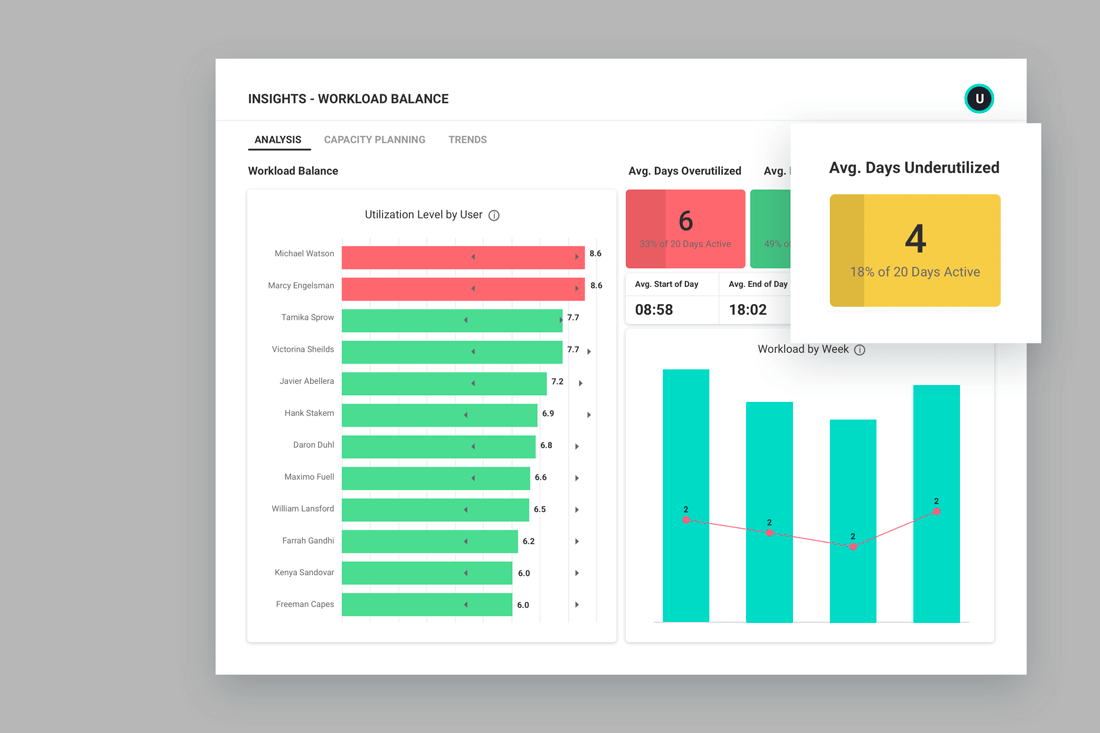In today’s competitive job market, employers must make the most of their workforce. However, it’s not uncommon for organizations to have underutilized employees – individuals who have valuable skills and talents that aren’t fully recognized in their current roles. Identifying and addressing underutilized employees can improve productivity, boost employee morale and increase job satisfaction.
In this post, we’ll explain everything you need to know about employees who are underutilized at work including what you can do about it.
What is employee underutilization?
Employee underutilization shows up in multiple ways depending on your employees and the specific work your company does. For instance, an employee who consistently completes tasks within deadlines but isn’t given additional responsibilities or challenges would be considered underutilized. This employee could contribute more to the organization while also being pushed to grow their own skills. Another example is a team member who has unique skills or expertise, such as being bilingual or having experience in another department’s roles but is not provided opportunities to leverage these strengths.
The impact of underutilized employees
Underutilization significantly impacts employee morale and productivity for the worse. When employees feel their skills and potential aren’t put to use, they may become disengaged, unmotivated or disenchanted with their work. This can lead to decreased productivity, higher turnover rates and a general decline in the overall performance of the team or organization.
According to a survey by Gallup, disengaged employees are estimated to cost the U.S. economy up to $550 billion annually in lost productivity. It’s clear that organizations failing to address employee underutilization not only miss out on the full potential of their workforce but also risk financial losses.
How to find employees who are underutilized at work
There are several ways managers and leaders can identify which employees aren’t being used to their full potential at work.
Signs of an underutilized employee
Some common signs of underutilized employees include:
- Lack of motivation or enthusiasm in their work
- Consistently completing tasks ahead of schedule or with minimal effort
- Expressing frustration or dissatisfaction with their current role
- Having skills or expertise that aren’t being used in their current job
- Seeking additional challenges or responsibilities
It’s important to note that these signs alone may not be conclusive proof an employee isn’t being fully leveraged, because some individuals may exhibit these behaviors for other reasons. However, these are valuable starting points for further investigation.
Tools and techniques for spotting underutilization
There are several tools and techniques to identify underutilization in employees. Employee performance reviews, for example, provide valuable insights into individual performance and potential areas of underutilization. Regular check-ins and candid conversations with employees also help managers gauge their level of job satisfaction and identify any areas where they may be put to better use.
Employee surveys or feedback mechanisms also provide employees with a way to express their thoughts, concerns and ideas regarding their role and development within your organization. However, self-reporting may not be enough for your organization to spot underutilized employees, especially because many employees will not feel comfortable providing completely honest information about their utilization.
Software like ActivTrak’s Workload Management provides objective data on employee utilization, including the ability to pinpoint employees who are working faster than expected while still hitting goals. Productivity monitoring can also give you insight into productivity trends across teams and individuals, allowing you to pick out standout team members.
Strategies to help underutilized employees
Once you’ve identified underutilized employees, it’s important to implement strategies to help them reach their full potential. Here are six strategies to consider:
1. Encourage skill development and training
Offering skill development and training opportunities is a powerful way to support underutilized employees. Providing access to workshops, courses or certification programs help employees acquire new skills or enhance existing ones. This can make them more valuable assets to the organization. By investing in their professional growth, you demonstrate a commitment to your employees’ development and overall job satisfaction.
2. Redefine job roles and responsibilities
You may notice some employees’ job descriptions don’t match their skills or the tasks they’re completing. It’s a good idea to redefine job roles and responsibilities to better resonate with employees’ strengths and interests. Just because an individual was hired to fill a certain role doesn’t mean that they can’t provide value to others. If workloads aren’t distributed evenly, update roles and reassign responsibilities to team members who have the bandwidth and skills to help. By delegating tasks that fully leverage their skills, employees feel more engaged and valuable in their roles, which increases both job satisfaction and overall productivity.
3. Offer new challenges to employees
Providing opportunities for employee creativity and engagement can provide growth to the organization as a whole. Offer employees the chance to show their strengths in new ways, such as providing them roles in expansion efforts or new product development.
4. Give employees a chance to teach others
If you notice an employee is particularly adept at a tool or process, it may be a good idea to offer them the opportunity to teach other employees their ways. While some employees may have public speaking issues, some may jump at the opportunity to show their colleagues how to better use the tools available to them. Teaching other employees can provide them with social clout in the organization as well.
5. Provide mentorship opportunities
Often senior leadership may have more projects than they can handle but won’t know who to delegate tasks to. You can close this gap by creating a mentorship program within your organization, which allows senior leaders the opportunity to coach more junior team members. This will also increase communication between different levels of staff, so if one senior manager notes they need help in an area, another manager may know someone in their department who would be a perfect fit.
6. Promote open communication
Clear and honest communication is the best way to address employee underutilization effectively. Employers should encourage employees to express their thoughts, concerns and ideas freely, without fear of reprimand. Regular team meetings, one-on-one sessions or anonymous feedback all provide employees opportunities to bring up their concerns. From there, it’s up to leadership to actively listen to employees and address their needs, which will contribute to an environment that fosters full employee utilization.
Use ActivTrak to identify and support underutilized employees
Leverage ActivTrak’s workload management to identify underutilized employees at your organization. Pinpoint high-performing team members who complete tasks quickly and efficiently and reward them with new challenges and opportunities. Quickly spot employees who are adept at technologies or tools and give them an opportunity to train others.
Get a demo of ActivTrak today to find out how we can help you find and support underutilized employees.





